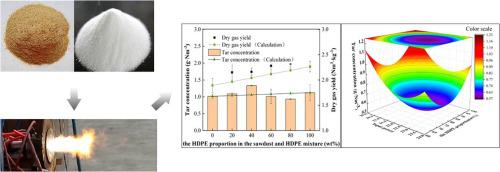当前位置:
X-MOL 学术
›
Energy Convers. Manag.
›
论文详情
Our official English website, www.x-mol.net, welcomes your
feedback! (Note: you will need to create a separate account there.)
Characterization of tar evolution during DC thermal plasma steam gasification from biomass and plastic mixtures: Parametric optimization via response surface methodology
Energy Conversion and Management ( IF 9.9 ) Pub Date : 2020-12-01 , DOI: 10.1016/j.enconman.2020.113407 Wenchao Ma , Chu Chu , Ping Wang , Zhenfei Guo , Bin Liu , Guanyi Chen
Energy Conversion and Management ( IF 9.9 ) Pub Date : 2020-12-01 , DOI: 10.1016/j.enconman.2020.113407 Wenchao Ma , Chu Chu , Ping Wang , Zhenfei Guo , Bin Liu , Guanyi Chen

|
Abstract Thermal plasma gasification has stimulated much recent interest for lower tar content, higher syngas yield, and more efficient energy utilization than conventional gasification. This context evaluated the influences of operating conditions (input power, the high-density polyethylene (HDPE) content, and steam/carbon (S/C) ratio) on tar evolutions during the plasma co-gasification of wood sawdust and HDPE. The single-factor analysis reveals that the increase in input power has a positive influence on the reduction of tars (from 1.13 g·Nm−3 to 0.84 g·Nm−3) and the conversion from light tars to heavy tars, simultaneously. The experimental tar concentrations at the HDPE proportion of 60% and 80% are 1.01 g·Nm−3 and 0.93 g·Nm−3, respectively, lower than the theoretical values, indicating a synergistic effect between wood sawdust and HDPE. The tar concentration shows a turbulent variation between 0.87 g·Nm−3 and 2.76 g·Nm−3 with the S/C ratio increasing. The light/heavy PAHs are the dominant compounds in the tars from plasma gasification and little phenols or furans are found in the components of tars. By using response surface methodology (RSM), a regression model between the three independent parameters and responses is gained and can effectively predict experimental results. According to this model, a minimum tar concentration of 0.54 g·Nm−3 can be obtained under the optimal conditions, which is comparatively lower than that from conventional gasification (1–100 g·Nm−3).
中文翻译:

生物质和塑料混合物的直流热等离子体蒸汽气化过程中焦油演化的表征:通过响应面方法进行参数优化
摘要 热等离子体气化最近引起了人们对比传统气化更低焦油含量、更高合成气产率和更有效能源利用的兴趣。该上下文评估了操作条件(输入功率、高密度聚乙烯 (HDPE) 含量和蒸汽/碳 (S/C) 比)对木屑和 HDPE 等离子体共气化过程中焦油释放的影响。单因素分析表明,输入功率的增加对焦油的减少(从 1.13 g·Nm-3 到 0.84 g·Nm-3)和轻焦油向重焦油的转化具有积极影响。HDPE 比例为 60% 和 80% 时的实验焦油浓度分别为 1.01 g·Nm-3 和 0.93 g·Nm-3,低于理论值,表明木屑和 HDPE 之间存在协同效应。随着 S/C 比的增加,焦油浓度在 0.87 g·Nm-3 和 2.76 g·Nm-3 之间呈现湍流变化。轻/重多环芳烃是等离子气化焦油中的主要化合物,焦油成分中几乎没有苯酚或呋喃。利用响应面法(RSM),得到了三个独立参数与响应之间的回归模型,可以有效地预测实验结果。根据该模型,在最佳条件下可以获得0.54 g·Nm-3 的最低焦油浓度,相对低于常规气化的焦油浓度(1-100 g·Nm-3)。轻/重多环芳烃是等离子气化焦油中的主要化合物,焦油成分中几乎没有苯酚或呋喃。利用响应面法(RSM),得到了三个独立参数与响应之间的回归模型,可以有效地预测实验结果。根据该模型,在最佳条件下可以获得0.54 g·Nm-3 的最低焦油浓度,相对低于常规气化的焦油浓度(1-100 g·Nm-3)。轻/重多环芳烃是等离子气化焦油中的主要化合物,焦油成分中几乎没有苯酚或呋喃。利用响应面法(RSM),得到了三个独立参数与响应之间的回归模型,可以有效地预测实验结果。根据该模型,在最佳条件下可以获得0.54 g·Nm-3 的最低焦油浓度,相对低于常规气化的焦油浓度(1-100 g·Nm-3)。
更新日期:2020-12-01
中文翻译:

生物质和塑料混合物的直流热等离子体蒸汽气化过程中焦油演化的表征:通过响应面方法进行参数优化
摘要 热等离子体气化最近引起了人们对比传统气化更低焦油含量、更高合成气产率和更有效能源利用的兴趣。该上下文评估了操作条件(输入功率、高密度聚乙烯 (HDPE) 含量和蒸汽/碳 (S/C) 比)对木屑和 HDPE 等离子体共气化过程中焦油释放的影响。单因素分析表明,输入功率的增加对焦油的减少(从 1.13 g·Nm-3 到 0.84 g·Nm-3)和轻焦油向重焦油的转化具有积极影响。HDPE 比例为 60% 和 80% 时的实验焦油浓度分别为 1.01 g·Nm-3 和 0.93 g·Nm-3,低于理论值,表明木屑和 HDPE 之间存在协同效应。随着 S/C 比的增加,焦油浓度在 0.87 g·Nm-3 和 2.76 g·Nm-3 之间呈现湍流变化。轻/重多环芳烃是等离子气化焦油中的主要化合物,焦油成分中几乎没有苯酚或呋喃。利用响应面法(RSM),得到了三个独立参数与响应之间的回归模型,可以有效地预测实验结果。根据该模型,在最佳条件下可以获得0.54 g·Nm-3 的最低焦油浓度,相对低于常规气化的焦油浓度(1-100 g·Nm-3)。轻/重多环芳烃是等离子气化焦油中的主要化合物,焦油成分中几乎没有苯酚或呋喃。利用响应面法(RSM),得到了三个独立参数与响应之间的回归模型,可以有效地预测实验结果。根据该模型,在最佳条件下可以获得0.54 g·Nm-3 的最低焦油浓度,相对低于常规气化的焦油浓度(1-100 g·Nm-3)。轻/重多环芳烃是等离子气化焦油中的主要化合物,焦油成分中几乎没有苯酚或呋喃。利用响应面法(RSM),得到了三个独立参数与响应之间的回归模型,可以有效地预测实验结果。根据该模型,在最佳条件下可以获得0.54 g·Nm-3 的最低焦油浓度,相对低于常规气化的焦油浓度(1-100 g·Nm-3)。











































 京公网安备 11010802027423号
京公网安备 11010802027423号